Investigating The Characteristics Of Persian Gardens: Taking A Close Look At Mahan Shah Zadeh Garden
Price
Free (open access)
Transaction
Volume
100
Pages
8
Page Range
211 - 218
Published
2008
Size
601 kb
Paper DOI
10.2495/GEO080211
Copyright
WIT Press
Author(s)
L. Tajaddini
Abstract
Iranians’ imagination of heaven, which is the reward of a person’s good deeds during their life, has shown itself in pleasant and green gardens where earthly gardens were made as representations of paradise. Iranians are also quite interested in making their earthly gardens and plantations around their buildings. With Iran’s hot and dry climate with a lack of sufficient water for plantation coverage, it becomes noticeable how important it is to Iranians’ art in making gardens. This study, with regard to examples, documents and library studies, investigates the characteristics of Persian gardens. The result shows that elements such as soil, water, plants and layout have been used in forming a unique style of Persian gardens. Bagh-e Shah Zadeh Mahan (Mahan prince garden) is a typical example and has been carefully studied. In this paper I try to investigate and evaluate the characteristics of a Persian garden by means of a descriptive approach. Keywords: environmental planning, Persian garden, landscape, shah zadeh garden, soil and water, gardening. 1 Introduction Garden construction has a long history in Iran. It has been important in the whole history, particularly in the Islamic era. Iranian ancient religion has insisted on agriculture and garden construction and has always appreciated that. Zardosht says the Ormazd: Oh! Creator of the world! Oh! The Unique Saint! Who is the fourth one who cheers the Earth most? The Ormazd replies: One who cultivates the most
Keywords
environmental planning, Persian garden, landscape, shah zadehgarden, soil and water, gardening.





